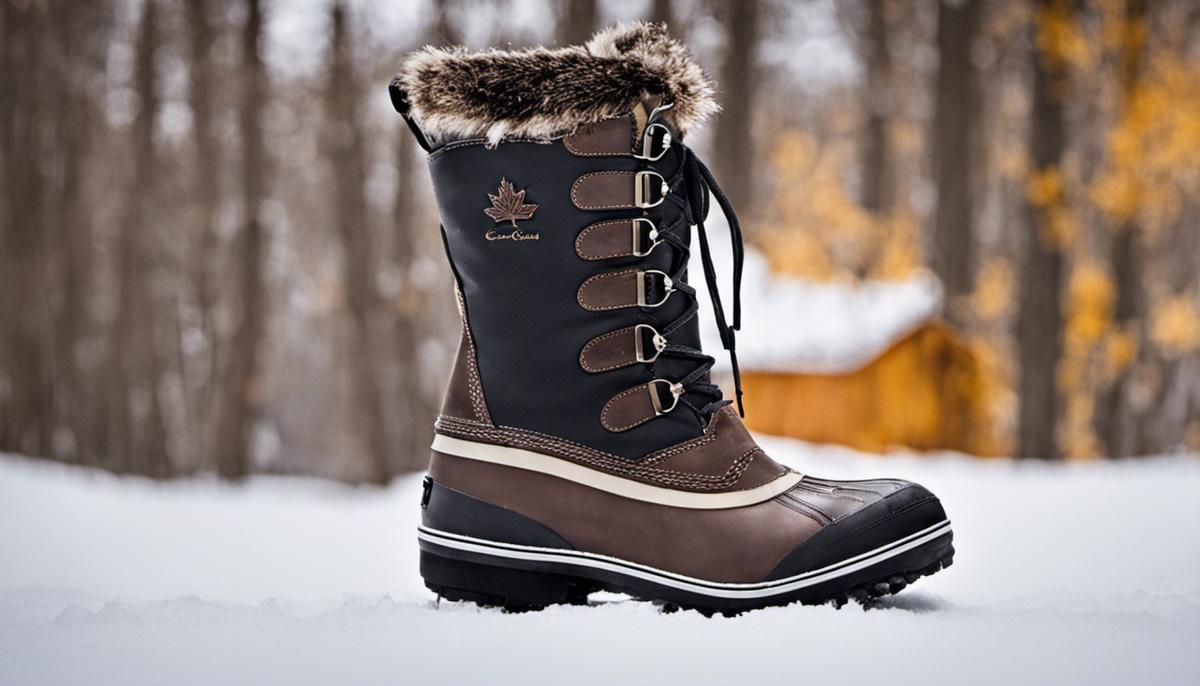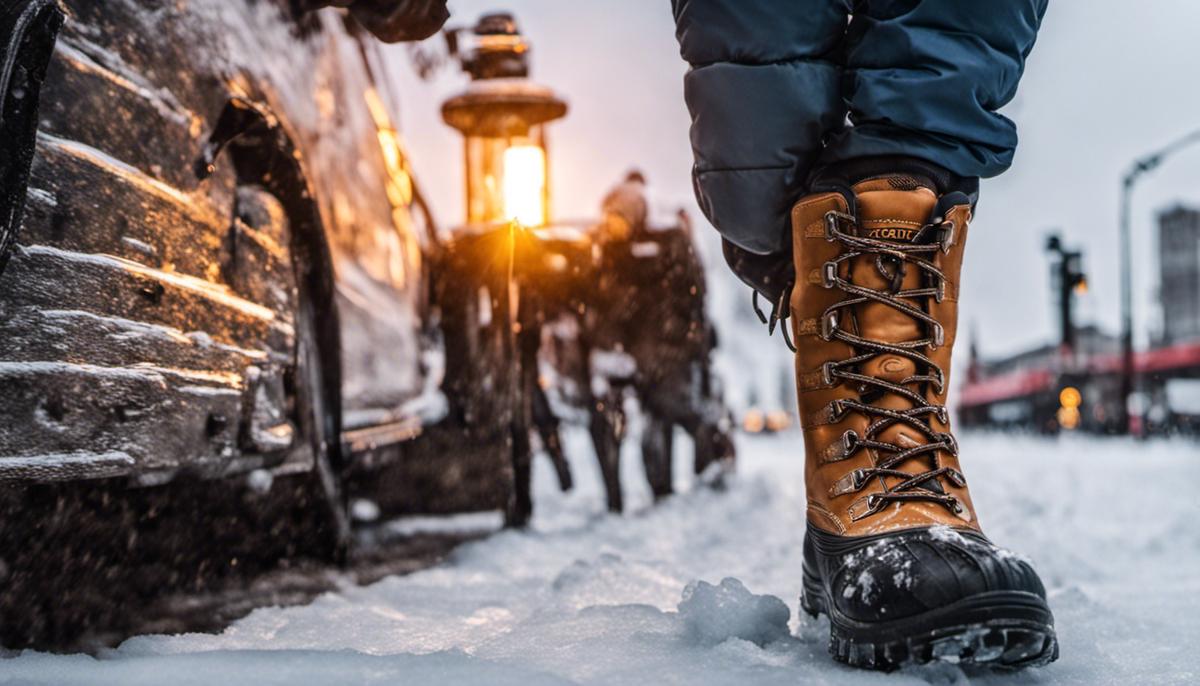Walking down icy Canadian streets during winter is a uniquely challenging task. To ensure safety, it’s essential to choose the right winter footwear and maintain them appropriately. This discussion emphasizes the need for certain footwear characteristics like insulation, water resistance, and traction to guard against slippery surfaces. Having boots with the right material and construction can mean the difference between comfortable, warm feet and an unpleasant winter experience.
Table of Contents
Choosing Suitable Winter Footwear
Unmasking the Must-Have Features of Winter Footwear for Canada’s Icy Winters
When temperatures drop and snowstorms roll in, Canada’s icy winter conditions demand more than just a pair of average snow boots. Choosing the right winter footwear to survive the harsh Canadian cold can seem daunting, but worry not! Today’s guide will dive deep into the key factors that should be on every family’s checklist when shopping for winter footwear.
First on the list is waterproofing. A feature that can’t be compromised, especially when you are dealing with slush-loaded sidewalks and knee-deep snow piles. Look out for boots labeled ‘waterproof’ to ensure feet remain dry and toasty during long winter walks or snowball fights.
Then comes insulation. Keeping those feet warm is crucial when temperatures dip to biting lows. Insulated boots with linings made from materials like wool, fleece, or synthetic fabric work wonders to trap body heat. Pay attention to boots with a specified temperature rating, so you know that they’re ready to tackle the level of cold your family will be braving.
Next, is breathability, a feature often overlooked in winter shoes. Breathable winter footwear helps prevent sweaty feet, which can lead to a chill when sweat freezes. Therefore, boots with technologies promoting airflow can provide the necessary ventilation, preventing sweaty, and eventually cold, feet.
Weight is another parameter on the list. Bulky boots can indeed be warm, but they also can make movement sluggish. Do your family a favor and go for the boots with a blend of lightness, durability, and insulation. This way, all the snow angels and snowball fights won’t be hampered by leaden footwear.
Durability should never be compromised if you want to get the most out of your boots season after season. Materials like genuine leather, high-quality synthetics, and strong rubber soles are known for their ability to withstand rough wear and rough winters.
The last but absolutely not the least factor is traction on slippery surfaces. A fall on black ice is the last thing anyone would want during a fun winter outing. Boots with soles designed for superior grip can provide additional safety on icy, slippery Canadian winter terrains.
Choosing winter footwear doesn’t have to be a daunting task, even in the face of icy Canadian winters. By keeping in mind these vital factors: waterproofing, insulation, breathability, weight, durability, and traction, families can confidently brave the harsh Canadian winters, without compromising on the joyful outdoor activities winter promises.
To all our fellow parents out there, stay warm, stay safe, stay informed! Ready to tackle winter one snowfall at a time? The perfect footwear is out there waiting, go and find it!

Proper Footwear Maintenance
Maintaining Winter Footwear for Longevity and Effectiveness
There lies the secret – ‘maintenance’. Just as you lovingly nurture your little one, taking time and effort to ensure wellbeing, so too your winter footwear begs for that TLC (Tender Loving Care). Not only does proper maintenance keep your boots looking good, but it also ensures they continue to perform their hard tasks – keeping your feet warm, dry, and safe in winter, year after year. So, without further ado, let’s plunge right into these crucial steps!
-
Regular Cleaning: Just returning from a snowy escapade? Instead of tossing off those boots and cozying by the fire, take a moment. Use a soft-bristle brush to dust off any loose dirt or salt stains—a known enemy of leather.
-
Dry Naturally: Even the toughest footwear has a gentle heart. Rapid changes in temperature may cause the material, especially leather, to crack. So, resist the temptation to dry them by the heater or radiator. Instead, let them air dry naturally at room temperature. Placing them upside down on an old newspaper will absorb moisture and expedite the drying process.
-
Conditioning: Maintaining your boots’ quality finish requires conditioning, particularly if made of leather. Naturally malleable, leather can lose its softness and flexibility over time if it’s not conditioned. Use a boot conditioner made specifically for winter footwear to keep it nourished and prevent cracking or drying out.
-
Rotating Pairs: We get it, everybody has a favorite pair of boots. But if you can, having two pairs to alternate between will let each breath, dry out, and regain its shape, instead of being subjected to the relentless onslaught of winter days.
-
Proper Storage: As the season transitions, say goodbye to your boots the right way. Thoroughly clean, condition, and dry them before storing. Do not forget to stuff them lightly with newspaper to help maintain their shape. Keeping them in a cool, dry place away from direct sunlight will preserve their longevity.
-
Regular Check-ups: Inspect your boots frequently for signs of wear and tear. Keep an eye out for cracks or stitching coming loose. Timely repair can prevent further damage and extend their life.
-
Replacing Insoles and Laces: Insoles can wear out more quickly than the boots themselves. Replacing worn down insoles will ensure comfort and proper fit. Similarly, laces may fray or break with use. Having fresh laces can add a new lease of life to your winter boots.
Through these small gestures, your winter footwear will reward you by being a trustful ally during those fierce winters. Remember, a moment spent in care today heralds days of comfort tomorrow. Now, go forth, and conquer those frosty trails in your well-maintained boots!

Using Slip-Resistant Products
Slip-resistant products to Enhance Safety on Icy Streets
Navigating icy streets is always a challenge. But did you know, apart from the usual must-haves such as waterproofing, breathability, good traction, insulation, and durability in your winter boots, several extra slip-resistant products can significantly boost your safety? What’s more, these products are easy to incorporate into your daily life and greatly complement other maintenance activities like drying, cleaning, conditioning, and regular inspection of your shoes.
Toward the top of the list are the ever-reliable shoe grips. These hardwearing, slip-on accessories provide exceptional stability on icy and slippery surfaces. Studded with metal prongs or coils, shoe grips bite into the ice beneath the shoes, offering a secure foothold, even on treacherous terrains. A commonly found version is the rubber overshoe, studded with metal grips.
Another fantastic inclusion could be heated insoles. Apart from providing fantastic insulation, they also enhance overall comfort and help with traction. Pair these with thermal socks to ensure your feet remain toasty and dry while navigating chilly conditions.
Non-stick soles are another remarkable innovation. Typically made from an oil-resistant rubber compound, these soles are designed to repel ice and snow, preventing your shoes from becoming slick and unwieldy.
Heel stoppers, another nifty accessory, can be fitted onto the heel of your boots. They provide additional grip when walking on icy pavements and prevent your shoes from unexpectedly slipping.
Gaiters are another excellent addition to your winter toolkit. Apart from protecting your lower legs from the cold, they also serve as an additional layer of defense against snow entering your shoes and causing discomfort or slippage.
Do remember that no amount of products can completely eliminate the risk of slipping on icy surfaces. It’s necessary to tread slowly, cautiously, and use handrails or other supports wherever possible. But the right gear can go a long way in keeping you safe during the winter season. Blend these tools with standard boot care techniques – rotating pairs, regular inspection, appropriate storage, and timely replacement of insoles and laces – and you would have a robust, full-proof strategy to march confidently through the icy streets.
Parenting pro-tip: Kids can also benefit from slip-resistant products, so consider investing in kid-friendly versions of these products. From a stroll to the bin to a snowball fight in the park, safety should always be a priority. After all, well-equipped parents leading by example pave the way for well-prepared kids.
Here’s to safe and enjoyable winter walks with our loved ones!

Maintenance routines such as the appropriate methods of cleaning, storage, and application of protective products can considerably extend the life of your winter boots. On the other hand, the application of slip-resistant products including ice cleats or grips can further enhance your safety on snowy or icy roads. Being adequately informed about these aspects will help in the purchase, maintenance, and use of winter gear; thus, enabling confident and safe navigation through harsh Canadian winters.

Zara Desertrose is an acclaimed fashion and lifestyle journalist with a Master’s in Fashion and Luxury Marketing. Known for her keen eye for style and cultural trends, Zara’s writing elegantly weaves together the latest fashion movements with lifestyle aesthetics. Her insightful critiques and trend forecasts make her a leading voice for anyone looking to stay at the vanguard of style.

